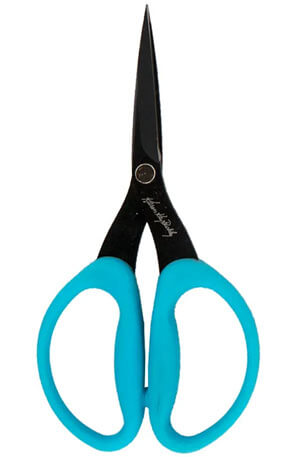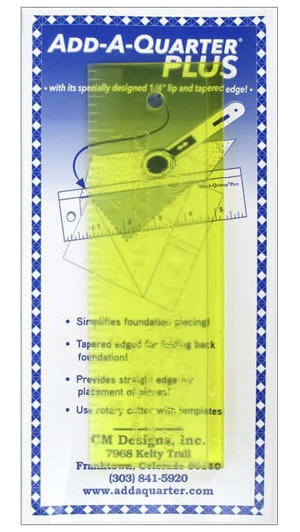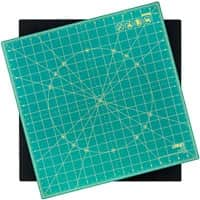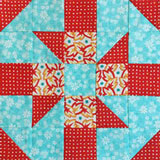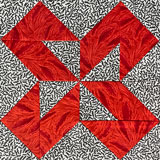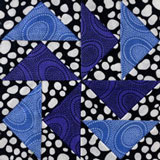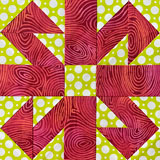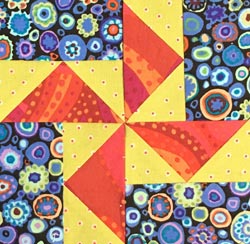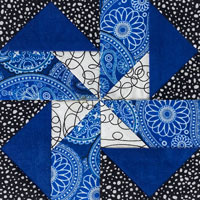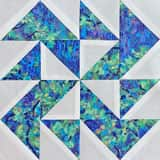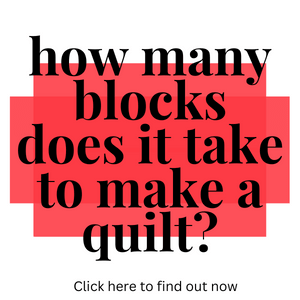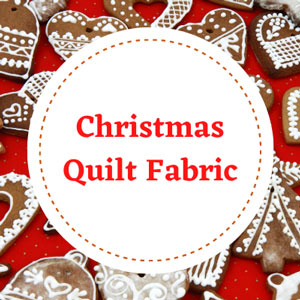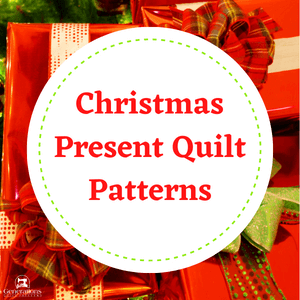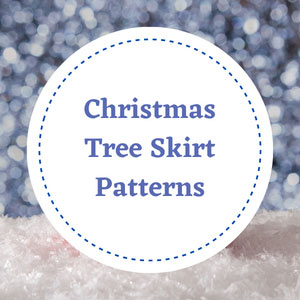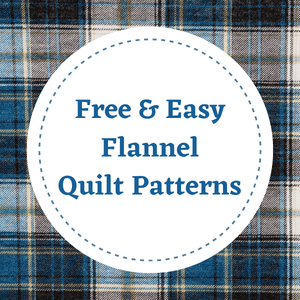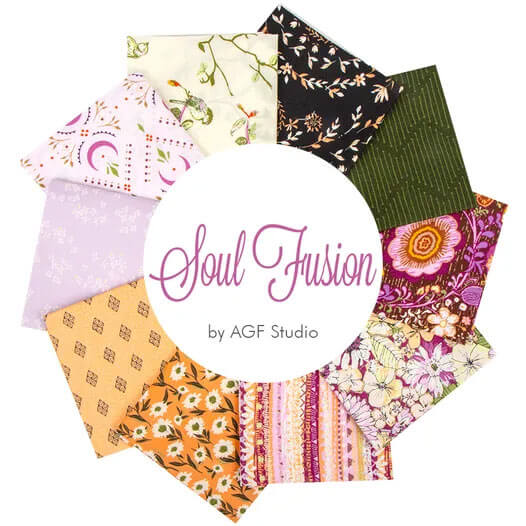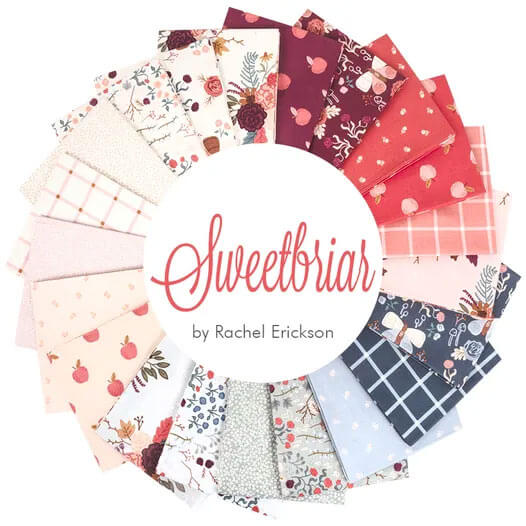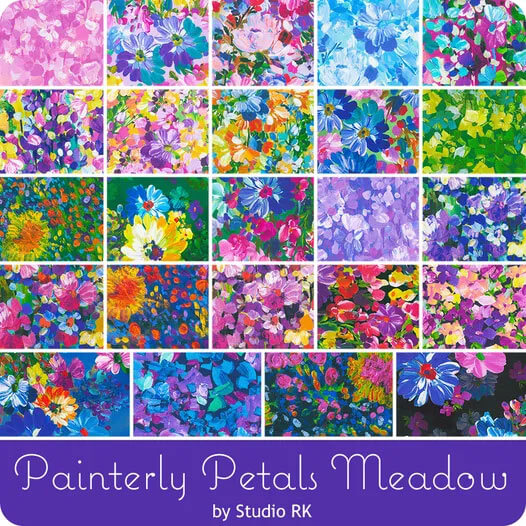- Home
- Free Quilt Block Patterns
- Yankee Puzzle Quilt Block
🧩 Yankee Puzzle Quilt Block Tutorial: Puzzle Solved with Smart Piecing! ✨
🎯 Paper piecing beats piecing panic — this Yankee's puzzle is officially solved! 💪
This post contains affiliate links, for which I receive compensation.
The Yankee Puzzle quilt block just met its match—and it's not expensive rulers or fussy trimming!
Paper piecing solves this puzzle by keeping those Flying Geese points sharp and your stress levels low. ✨
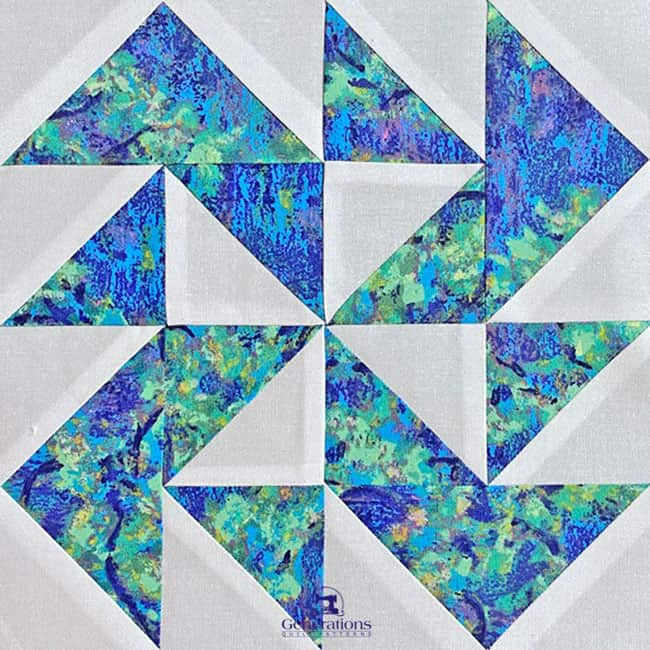
Instead of 12 separate trims, we're doing 4 sides per unit and calling it done.
Complete paper piecing tutorial in 6 sizes with free patterns because YOU deserve a simple solution!
Plus traditional piecing for anyone who's not ready to embrace the paper piecing magic yet — though as I always say, you never know unless you try! 😉
🎯 Navigate Smart, Quilt Smarter! 🗺️
Click and go — because puzzle-solving should be this easy everywhere! ✨
📋 General Instructions
⚡ PRINTING TIP: Need help printing this tutorial? Click here for easy instructions!
Several abbreviations are used on this page. They are:
- SA - seam allowance
- RST - right sides together
- HST - Half Square Triangle
- FG - Flying Geese
A 1/4" SA is used in this tutorial.
📥 Optional: Download and print the paper piecing pattern
To download the pattern, use the most current version of Adobe.
For accurate results, on Adobe's Print Menu page, under 'Page Size and Handling' set 'Custom Scale' to 100%. Then print.
Click here to see what it looks like on the Print Menu page.
Find your finished block size from the chart below. For each block you want to make, print the corresponding number of copies for a total of 4 units,
Download and Print Units | |
|---|---|
| # of Copies to Print | Finished Block Size |
| 1 | 4" |
| 1 | 5" |
| 1 | 6" |
| 2 | 8" |
| 4 | 10" |
| 4 | 12" |
After printing, use the 1" square graphic on the printed page(s) to double check that your patterns printed at the correct size.
Then cut out the required number of patterns from your copies. A rough cut is good enough—an 1/8"-1/4"-ish away from the outside dashed square.
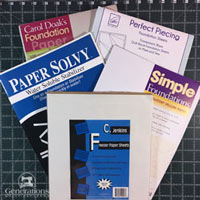
Not sure which paper to use?
Take a look at my review of several of the most popular brands available to us quilters on the market.
You want a super-easy paper to tear away—less stress on the stitches.
My must-have tools for paper piecing
Most of the tools you'll need for paper piecing, you likely already have. (Whew!!!!)
Compare your current inventory with the recommendations in 'Essential Paper Piecing Skills: The right tools for the job'.
In the meantime, these are the three must-haves in my paper piecing toolbox.
✂️ Cutting patches for your paper pieced Yankee Puzzle quilt block
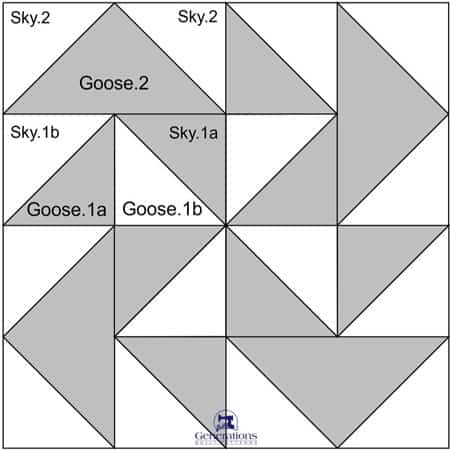
Sample Block Size: 8" finished / 8½" unfinished
Grid: 4x4
Attribution: Ladies Art Company
Barbara Brackman ID: #1103a
Design Type: Pinwheel | Paper piecing | 4-patch
Label your patches, unless you enjoy puzzle-solving the hard way! 🏷️🧩
Paper Piecing

 | Cutting Chart for a~ Paper Piecing ~ | ||||||||
|---|---|---|---|---|---|---|---|---|---|
| Patch | Fabric | Qty | Finished Block Size | Sub Cut | |||||
| 4'' | 5'' | 6'' | 8'' | 10'' | 12'' | ||||
| Goose.1a Sky.1a | Dark | 4 | 2⅜'' x 2⅜'' | 2⅝'' x 2⅝'' | 2⅞'' x 2⅞'' | 3⅜'' x 3⅜'' | 3⅞'' x 3⅞'' | 4⅜'' x 4⅜'' | |
| Goose.1b Sky.1b Sky2 | Light | 8 | 2⅜'' x 2⅜'' | 2⅝'' x 2⅝'' | 2⅞'' x 2⅞'' | 3⅜'' x 3⅜'' | 3⅞'' x 3⅞'' | 4⅜'' x 4⅜'' | |
| Goose.2 | Dark | 1 | 3½'' x 3½'' | 4'' x 4'' | 4½'' x 4½'' | 5½'' x 5½'' | 6½'' x 6½'' | 7½'' x 7½'' | |
| Unfinished Block Size | 4½'' | 5½'' | 6½'' | 8½'' | 10½'' | 12½'' | na | ||
| Grid Size | 1'' | 1¼'' | 1½'' | 2'' | 2½'' | 3'' | na | ||
🧩 Paper Pieced Units for Puzzle Solving Made Simple!
Ready to solve this puzzle the smart way? You're in the right spot! These instructions walk you through creating perfect Yankee Puzzle units using paper piecing magic. ✨
First, let's look at our pattern.
Notice that when you flip it from pattern side to fabric side, the Goose.1a&b and Sky.1a&b patches appear reversed — this is precisely how it should look.
Don't worry, you're on track!
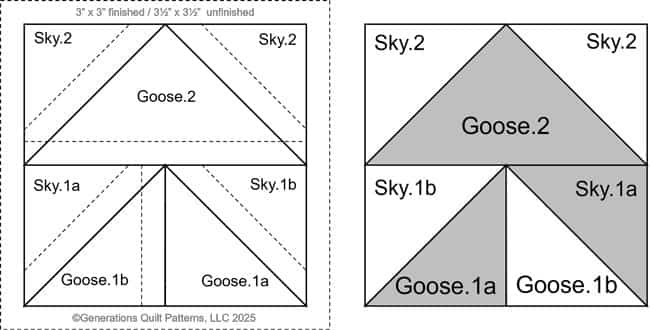 Pattern side (left), fabric side (right)
Pattern side (left), fabric side (right)✂️✂️ Subcutting your patches
Goose.1a&b, Sky.1a&b, and Sky.2 are cut once on the diagonal to make our HST shapes.
Goose.1 is cut twice on the diagonal to make the QST shapes.

Creating the unit
Use a dot of Elmer's Washable Glue Stick® to hold Sky.1a in position on the unprinted side of the pattern. Use the dashed guidelines for an accurate, no-fuss placement.
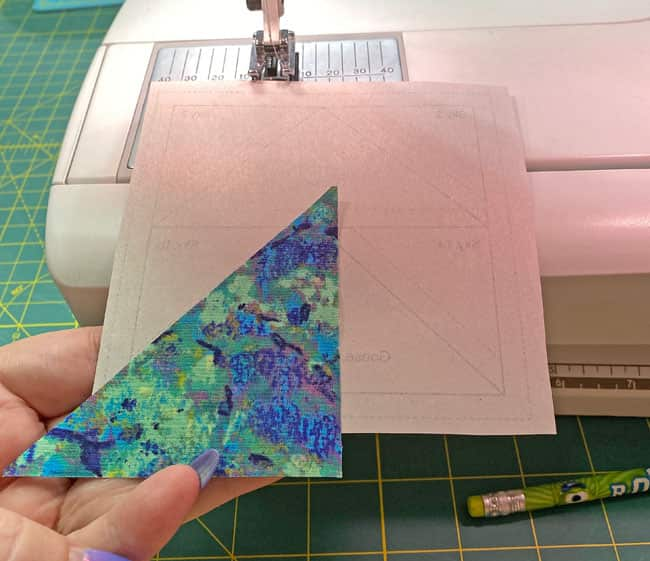
We need to make a few adjustments to our sewing machine settings to paper piece.
- Reduce your stitch length to 16–20 stitches per inch (1.3-1.6 mm). This perforates the paper and stabilizes the seam when you remove the pattern. [Learn more about stitch length here.]
- Reduce your machine's speed or just plain slow down. Sew only as fast as you can AND stay on the solid stitching line.
- Install an open toe appliqué foot (sometimes called an 'embroidery' or 'satin stitch' foot) if you have one (it makes it easier to see where you're stitching).
- Use a larger needle (90/14) IF you have problems removing the pattern. Personally, I use an 80/12 Microtex Sharp for paper piecing without any issues.
Match the point and sides edges of Goose.1b to Goose.1a.
✅ KEY TECHNIQUE: Avoid dark fabrics shadowing through lighter ones
In our sample, the background fabric is much lighter than the dark.
To keep the darker print from shadowing through the light background in the finished block, nudge the edge of the lighter patch a couple of threads past that of the print. (blue arrow)
A simple technique to prevent a lot of angst later.
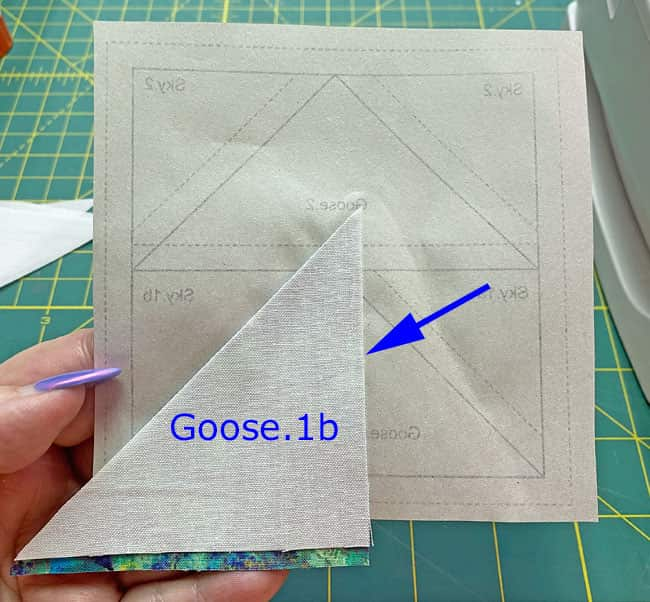
By taking the time to do this matching, there won't be any excess to trim away.
Sew the seam.
✅ KEY TECHNIQUE: ALL PAPER PIECED SEAMS
ALL the seams in paper piecing are stitched by starting a generous 1/4" before the solid line between patches and ending a generous 1/4" after that line ends. The next line of stitches that cross this seam secures the ends—just like in traditional piecing.
If the seam begins/ends at the outside edge of the block, start and stop your stitches past the outside dashed line surrounding the block.
Use this technique every time you sew a seam.
The only time I might use backstitches is at the outside edges, but never inside the block or unit. I find the shorter stitch length with good thread tension holds my stitches quite well.
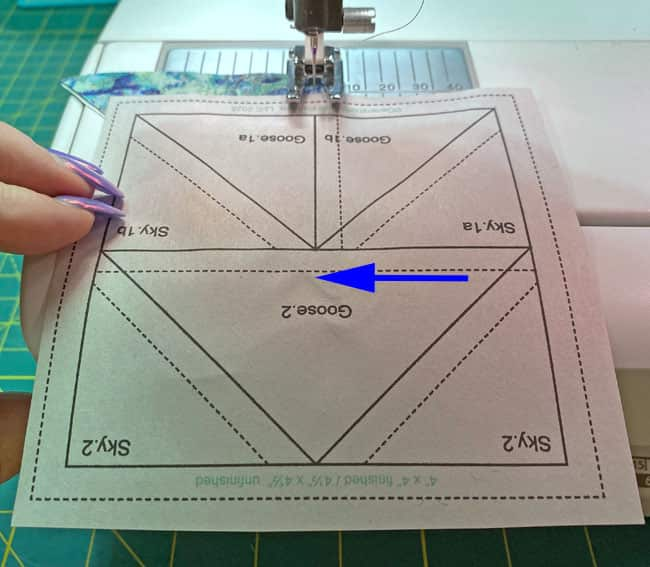 Stop your stitches roughly at the arrow point
Stop your stitches roughly at the arrow pointAfter pressing, the edges of your patches should be right at the dashed guidelines (blue arrow), and don't need to be trimmed. (Always after working smarter, not harder! 😉
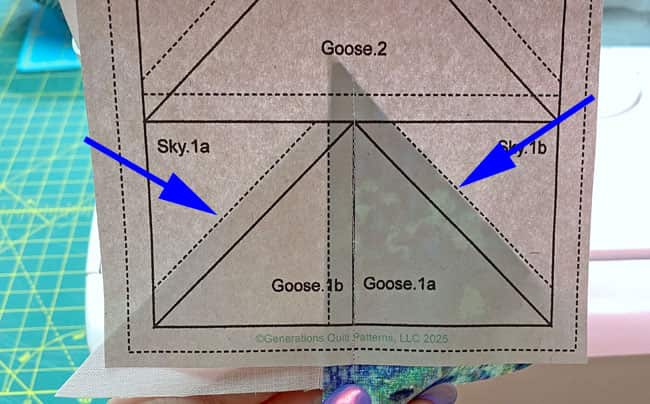
With RST, match the long bias edge of Sky.1a to Sky.1b.
Stitch the seam and press.
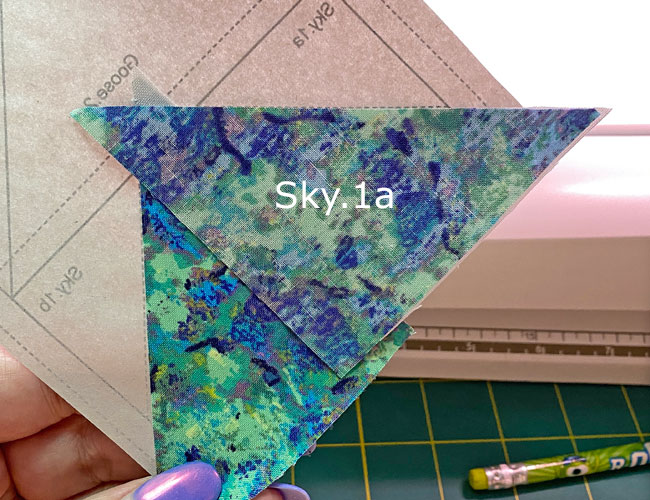
Repeat for Sky.1b. Remember to nudge it over a couple of threads if it's much lighter than your 1a fabrics.
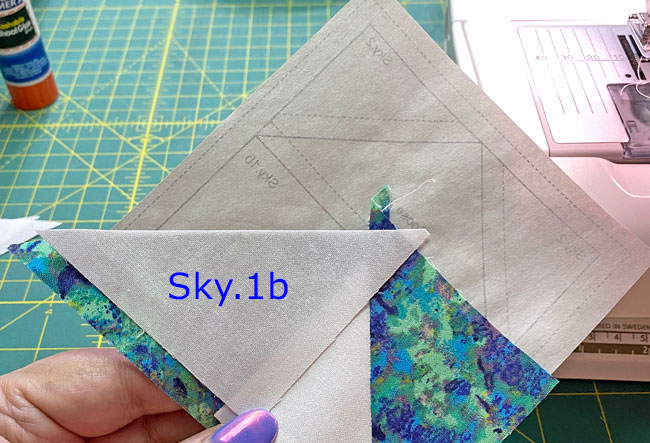
Stitch and press.
✅ KEY TECHNIQUE: Establish the placement line for the next patch
As your cutting mat, pull the paper away from the stitches where your stitches crossed. If your paper tears more than you like, use a bit of Magic Tape® to repair the pattern from the paper side.
Position the edge of your ruler with the solid line between Sky.1a and 1b and Goose.2. Use your thumbnail to crease the pattern on the line.
Fold the pattern back on itself on that line.
Match the 1/4" mark on your ruler with the folded edge and trim away the excess fabric, leaving behind an exact 1/4" SA.
At your cutting mat, pattern side up, pull the paper away from your stitches in the center (blue arrow).
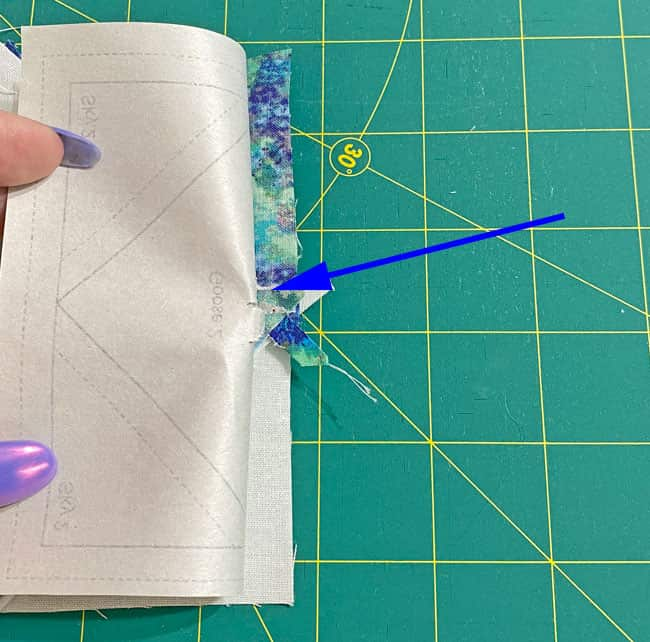
Open up the pattern, and match the edge of your ruler with the solid line and crease long the edge.
Position the 1/4" mark on your ruler over the folded edge and trim away the excess fabric, leaving behind a perfect 1/4" seam.
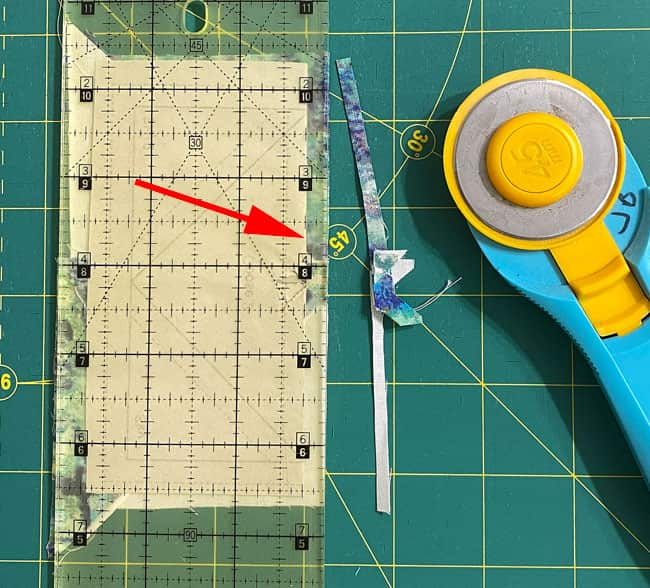
With RST, line up the long bias edge of a Goose.2 with the freshly cut one.
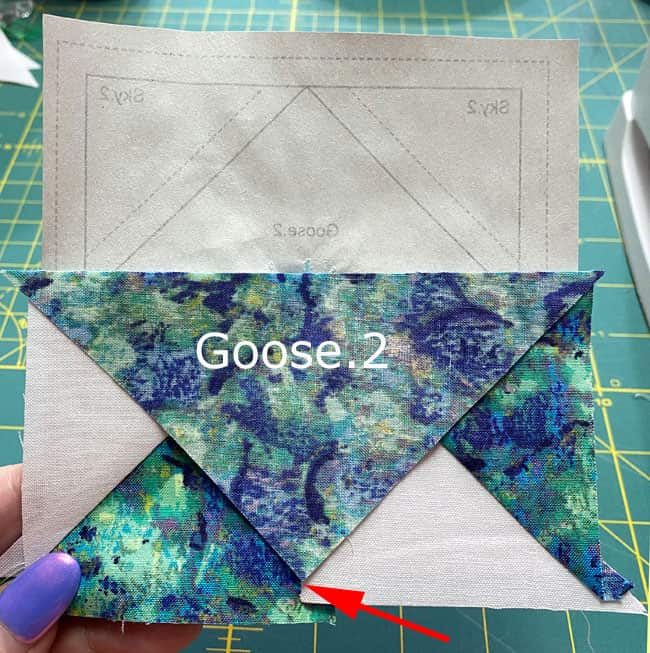
Since this seam runs from one side of the pattern clear to the other, this is a candidate for chain piecing if you're making all your units at once.
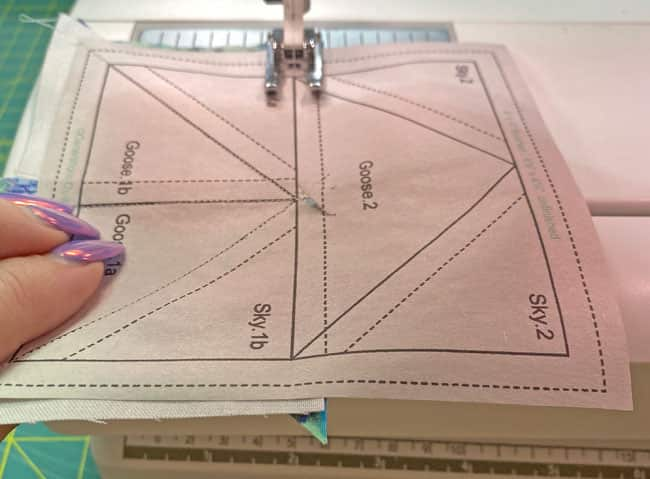
After pressing, this patch is pretty darned close to those dashed guides (blue arrows) that represent the 1/4" SA. I won't bother to trim them.
However, if they extend beyond by much more, I would to create the accurate placement line for the Sky.2s using the 'Key Technique' above.
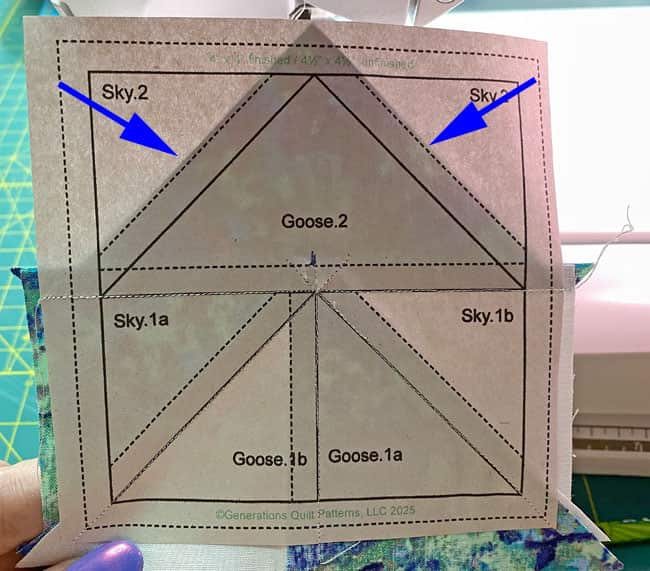
Match the 1st Sky.2's long edge to one of the open sides of Goose.2. It doesn't matter which side you start on, though it does help to be consistent if you're assembly line sewing.
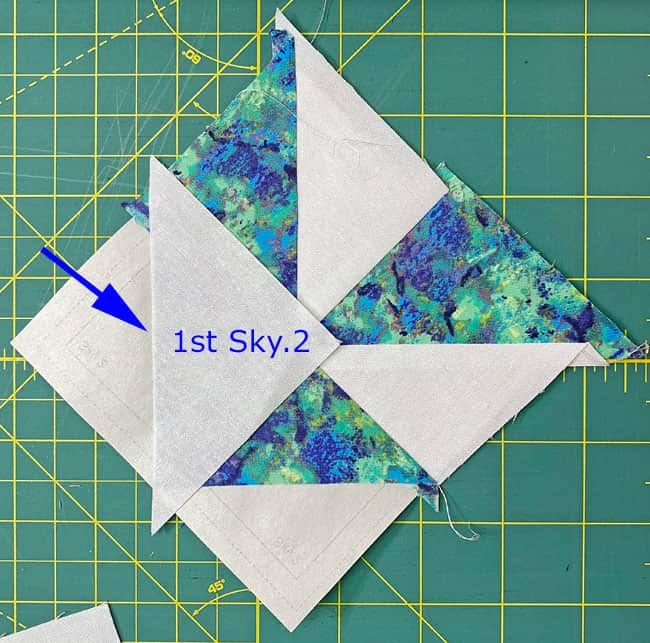 I've nudged this a couple threads because the patch is so light
I've nudged this a couple threads because the patch is so lightStitch and press.
Repeat the process for the second Sky.2.
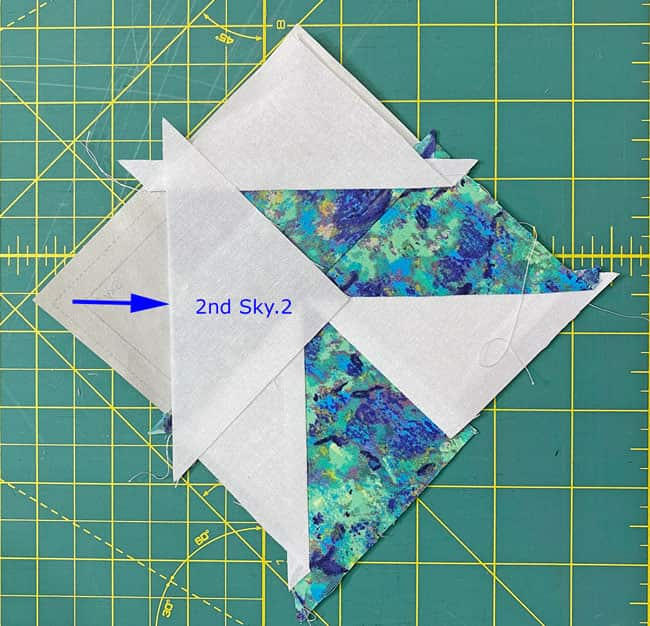
✂️✂️ Trimming the units to size
Place a neatly pressed Yankee Puzzle unit, pattern side up, on your cutting mat.
Match the 1/4" mark on your ruler with one side of the solid square that surrounds our Yankee Puzzle unit.
Trim away the excess with your rotary cutter.
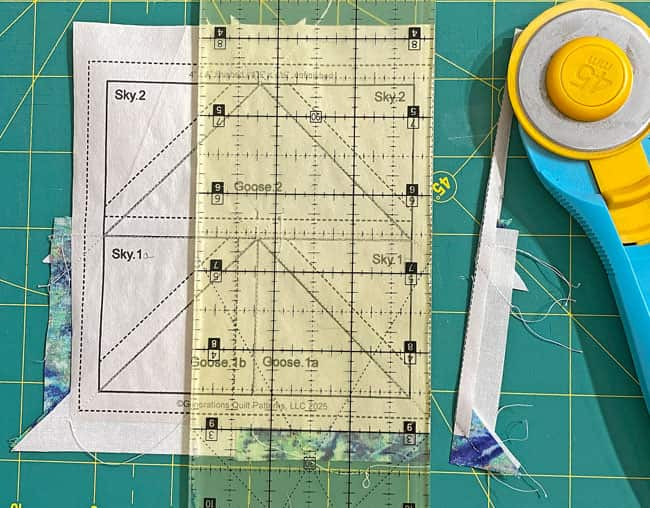
Repeat for each side of every unit.
Here are units from 'just stitched' (left), trimmed (center), and the waste on the right side. All the points and angles are precisely where they should be.
All for the simple act of sewing on a line.
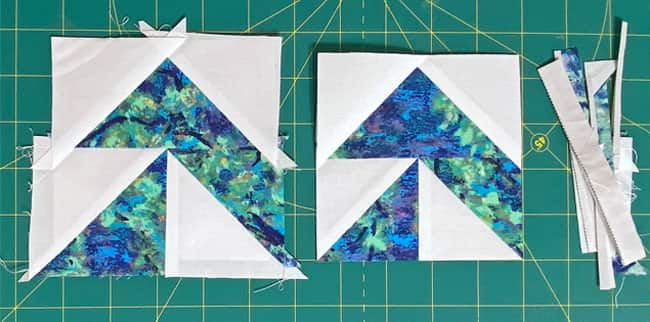 A Yankee Puzzle unit, untrimmed (left), trimmed (center) with the waste on the right
A Yankee Puzzle unit, untrimmed (left), trimmed (center) with the waste on the rightRemove the paper
The job of the paper pattern is complete. All our outside edges are on straight of grain, so this unit is no different from those that are traditionally pieced.
Remove the paper from all your units.
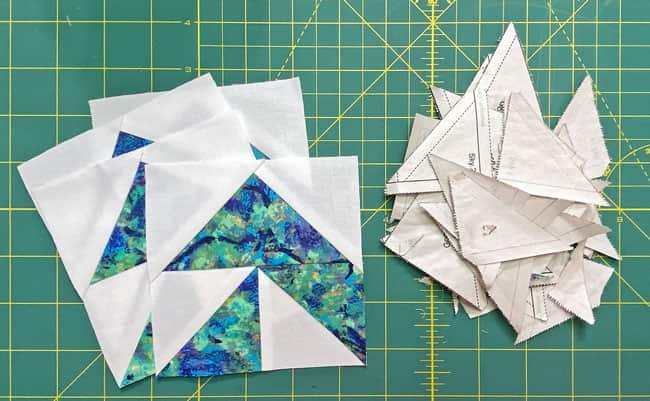
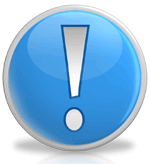
The paper piecing is complete. From this point forward, return your stitch length to the one you regularly use for piecing and install your favorite 1/4" presser foot.
✨ Time to solve this puzzle!
The block assembly is the same, whether you paper pieced your units or traditionally pieced them. All the seams are pressed in the same directions.
Arrange your units into the Yankee Puzzle design. The Goose.2s point to the top or right in the top row and to the bottom or left in the bottom row.
The paper pieced version is in blue/green (left side). The traditionally pieced option is in pinks/orange (right side).
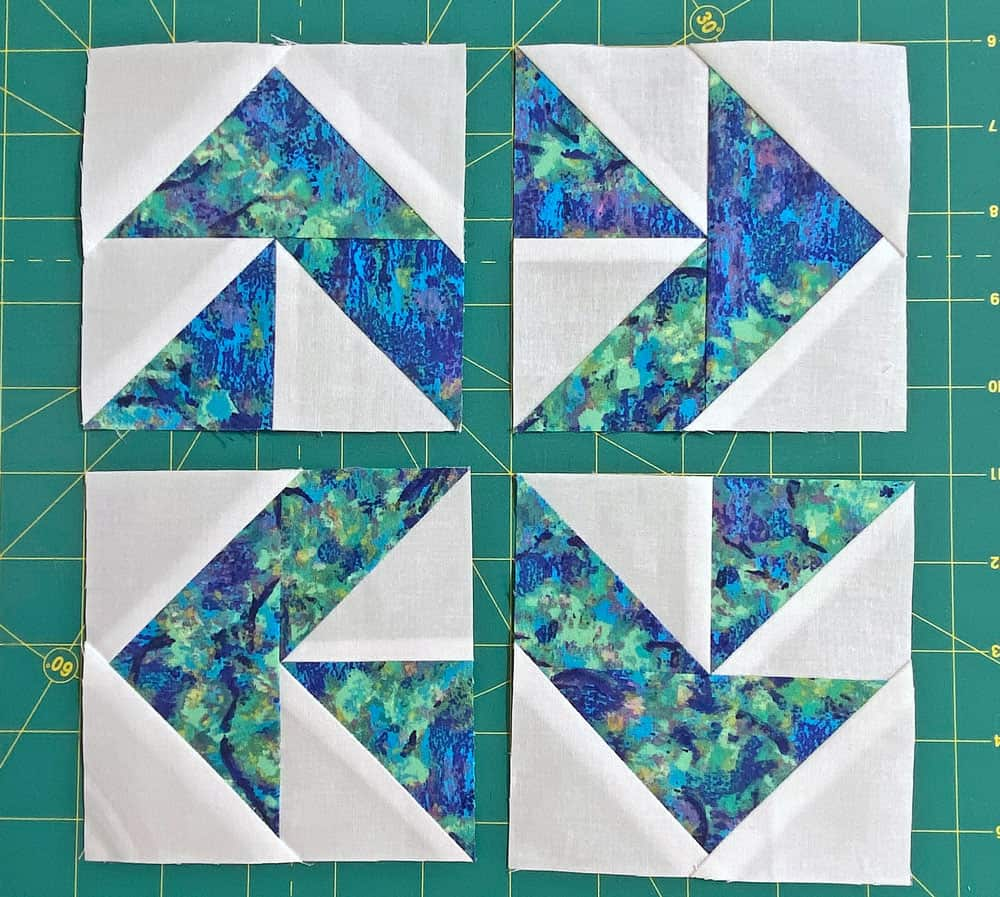 Paper pieced units
Paper pieced units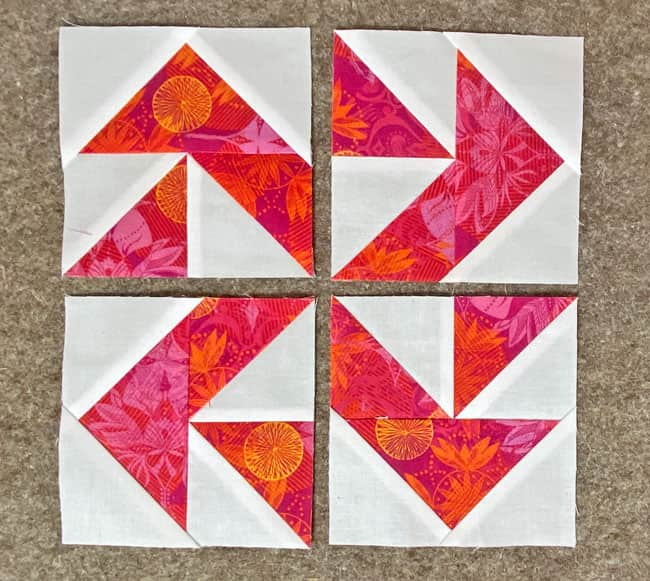 Traditionally pieced units
Traditionally pieced unitsStitch the units in each row together, The SAs of the pinwheel that forms in the center nest to make matching the points easier.
I do like to pin this to hold the edges and points in position,

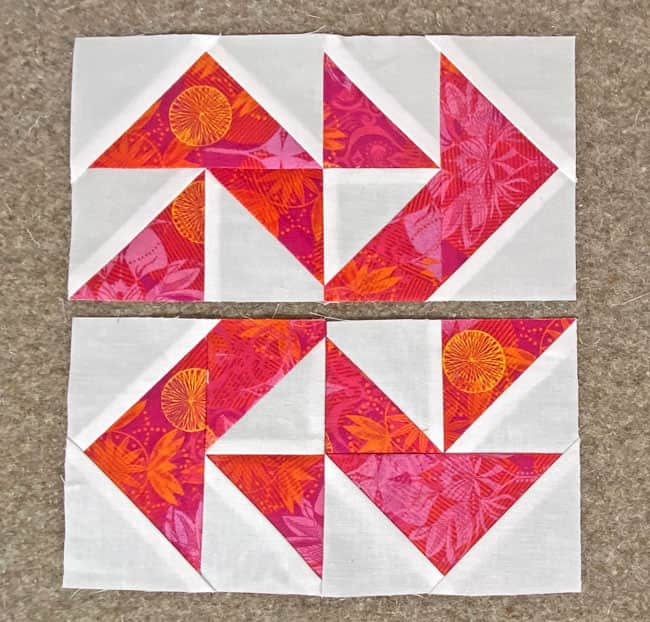
Join the rows, again, I pin to hold everything in position.
Here are the results of our efforts, regardless of whether you used traditional or paper piecing methods.
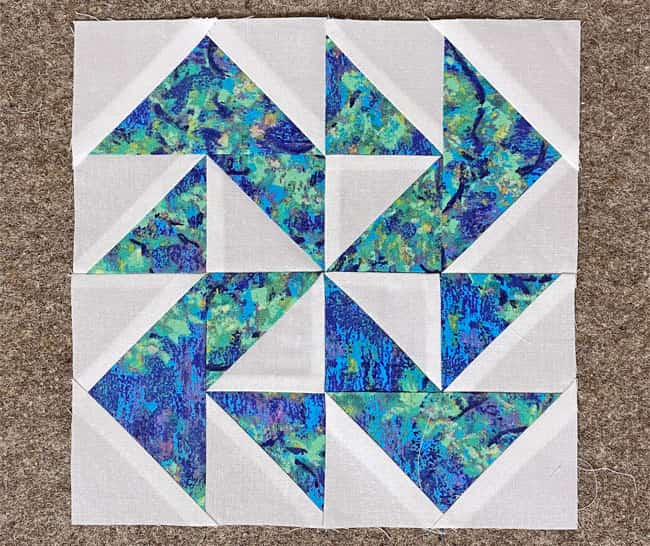
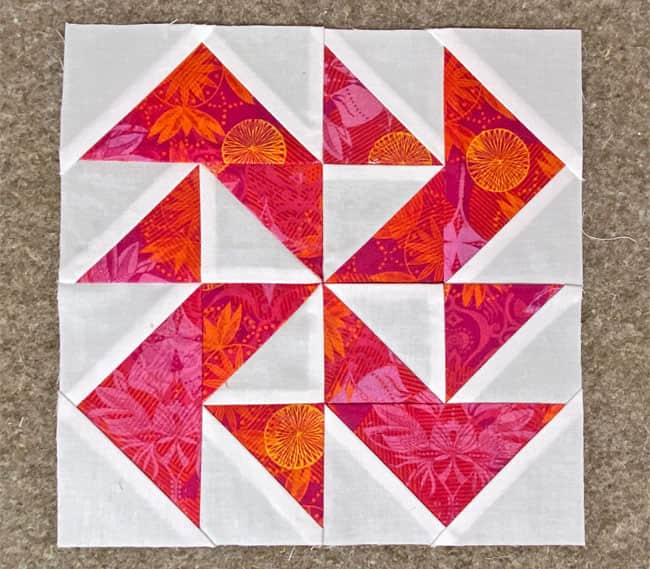
Flipping the block over, you can see how all the pressing works to create a flat block.
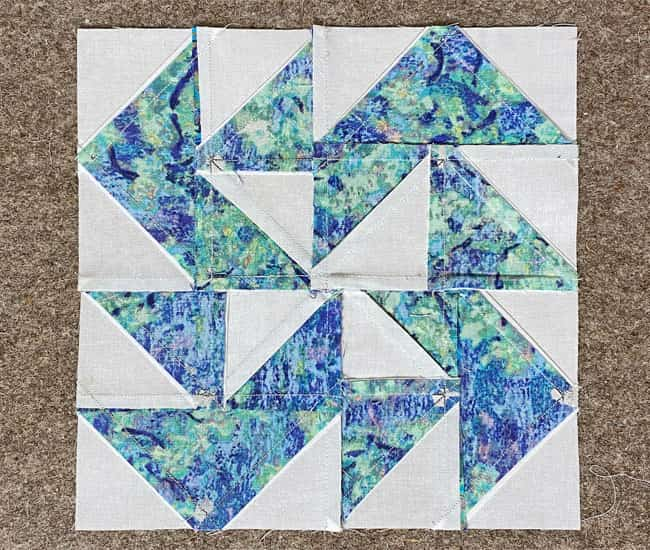 All that's left is to remove those final bits of paper pattern
All that's left is to remove those final bits of paper patternUntil next time, may your seams be straight and your bobbins be full!
Puzzle officially cracked! 💫
This gorgeous Yankee Puzzle quilt block shows exactly why paper piecing beats piecing panic hands down! 🧩
Perfect points without the stress, beautiful results without the hassle—smart technique wins again! 🎯
📌 Solve It Now, Pin It Forever!
🧩 Keep this Yankee Puzzle solution handy because you'll definitely want to make more! ✨ Share the paper piecing love! 💪

🎯 Your Next Block Obsession Lives Here! 💕
You've conquered the Yankee Puzzle — now feast your eyes on these gorgeous cousins! Each design brings its own twist to the pinwheel magic.
Ready to fall in love with your next block? 💫
🌀More playful pinwheel quilt blocks to stitch!
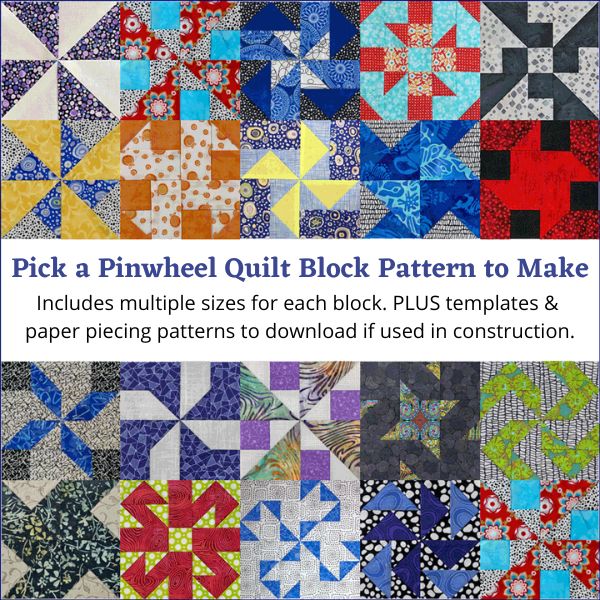
You've finished your pinwheel quilt block, and you're ready for more!
Our pinwheel quilt blocks are a delightful blend of playful interlocking patterns and vivid, eye-catching color. The interlocking patterns dazzle your eyes and inspire your creativity, while our step-by-step instruction ensures that you can create these stunning blocks with ease.
Click here to dive in and turn your fabric into MAGIC!
For even MORE blocks to make… 🧩🎨

...visit our Free Quilt Block Pattern Library, with over 260+ blocks to choose from in multiple sizes.
Free downloads are included in all sizes for any blocks require paper piecing patterns or templates.
- Home
- Free Quilt Block Patterns
- Yankee Puzzle Quilt Block
